You can listen to Hoosier History Live! live on the air each Saturday, or listen online at the WICR website during the broadcast on any computer with speakers, anywhere, or on a smartphone. We invite you to visit our website!
Sept. 17 show
Irvington neighborhood history in Indy
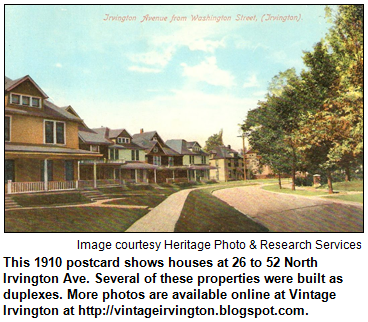 A historic neighborhood on the eastside of Indy that dates to the 1870s, Irvington has a past as colorful as its leafy, towering trees. But there's also fresh activity under way in this neighborhood, which has been home to artists and civic leaders, as well as to Butler University until the 1920s.
A historic neighborhood on the eastside of Indy that dates to the 1870s, Irvington has a past as colorful as its leafy, towering trees. But there's also fresh activity under way in this neighborhood, which has been home to artists and civic leaders, as well as to Butler University until the 1920s.
To explore the neighborhood, which has residences ranging from Queen Anne-style and Second Empire houses to Sears kit homes and bungalows, Nelson will be joined in studio by Irvington resident Paul Diebold, senior architectural historian for the State DNR and author of Greater Irvington.
Our guests also will include Irvington native Steve Barnett, a graduate of Howe High School (one of the neighborhood's landmarks), who is executive director of the Irvington Historical Society.
Nelson also will be joined by Amandula Henry, executive director of the Irvington Development Organization. She will share insights about new initiatives in the former town, which was annexed into Indy in 1902.
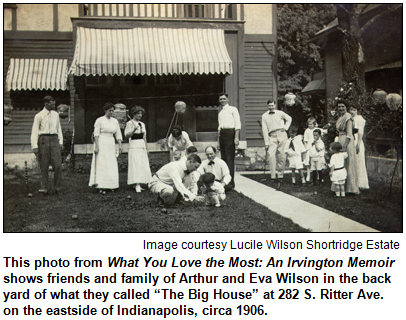 Irvington's founders named the neighborhood in honor of their favorite author, Washington Irving. Ever notice many Irvington streets also are named for authors, such as Hawthorne (Nathaniel) and Emerson (Ralph Waldo) avenues?
Irvington's founders named the neighborhood in honor of their favorite author, Washington Irving. Ever notice many Irvington streets also are named for authors, such as Hawthorne (Nathaniel) and Emerson (Ralph Waldo) avenues?
Boundary streets, though, are difficult to identify. Irvington is so beloved that many eastside residents want to consider themselves part of it. Our guest Paul Diebold, who has lived in Irvington for 24 years, reports a favorite saying: "Irvington has no boundaries, but is a state of mind."
The Historic Irvington Community Council represents an area defined by Emerson on the west, Edmondson Avenue on the east, 10th Street on the north and Brookville Road on the south.
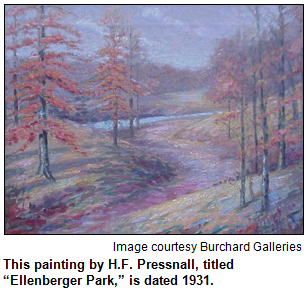 Our show will come on the eve of the Irvington Home Tour, which is set for Sunday (Sept. 18) from noon to 5 p.m.
Our show will come on the eve of the Irvington Home Tour, which is set for Sunday (Sept. 18) from noon to 5 p.m.
And next year marks the 10th anniversary of the opening as a cultural/arts center of the Bona Thompson Memorial Center, which was built in the early 1900s as Butler's library. To celebrate the 10th anniversary of the $1 million restoration, a series of events will be held throughout Irvington.
Other neighborhood landmarks include the Irving Theater; sprawling Ellenberger Park, which opened in 1911; and the Benton House, which was built in 1873 and became the home of Butler faculty members, including a president.
With the presence of Butler, which moved to the neighborhood in 1875 from its initial location on College Avenue in the Old Northside, Irvington flourished as a cultural hub of the city.
Notable residents included artist William Forsyth, a member of the renowned Hoosier Group of painters (his artwork periodically depicted scenic Pleasant Run Creek, another landmark) and cartoonist Frank McKinney "Kin" Hubbard, creator of the iconic Abe Martin character.
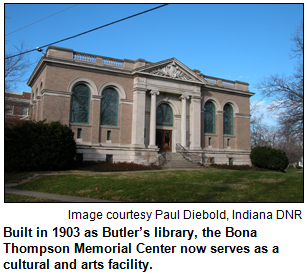 Notorious residents included D.C. Stephenson, the Grand Dragon of the Ku Klux Klan during the 1920s. His imposing home, which he modeled after the Klan's headquarters in Atlanta, still stands and is privately owned.
Notorious residents included D.C. Stephenson, the Grand Dragon of the Ku Klux Klan during the 1920s. His imposing home, which he modeled after the Klan's headquarters in Atlanta, still stands and is privately owned.
Forsyth and various artists also have identified themselves as the Irvington Group. Our guest Steve Barnett has served as curator for their exhibits, as well as many others at the Bona Thompson Center. He also has tracked down the histories of more than 1,600 homes in areas of Irvington listed on the National Register of Historic Places, including Irvington Gardens, Pleasanton and Emerson Addition.
According to the Indianapolis Business Journal, more than 78 percent of Irvington homes were built before 1960. The IBJ estimates the population of the Irvington area as about 11,460.
In recent years, Irvington has become known for its locally owned restaurants, coffee shops and small businesses. 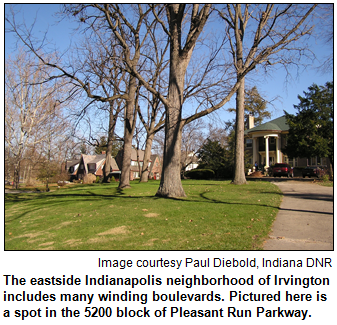 Aside from marketing initiatives such as "Celebrate Irvington" and "Shop Irvington," the neighborhood also has carved out a distinct identity for its celebrations and festivals during Halloween season, including popular "ghost" tours through the neighborhood.
Aside from marketing initiatives such as "Celebrate Irvington" and "Shop Irvington," the neighborhood also has carved out a distinct identity for its celebrations and festivals during Halloween season, including popular "ghost" tours through the neighborhood.
In addition to his book Greater Irvington, our guest Paul Diebold is the author of The History and Architecture of Meridian-Kessler; they are considered Indy's first neighborhood-based architectural history books.
Even Nelson, our host, has gotten into the Irvington act. He penned the foreword for What You Love the Most: An Irvington Memoir, written by Indianapolis author Carol Faenzi. It is a memoir about the building of a spacious, historic home by Arthur Wilson, an early neighborhood resident.
Beginning with its founding along the Old National Road (East Washington Street), Irvington was known for its restrictions on alcohol sales. According to some sources, one of Irvington's founders, Jacob Julian, a former prosecutor, was a teetotaler.
Speaking of the Old National Road: Many streets in Irvington, particularly those south of Washington Street, are known for being curvy and narrow. That's because many were built for travel by horse, not car.
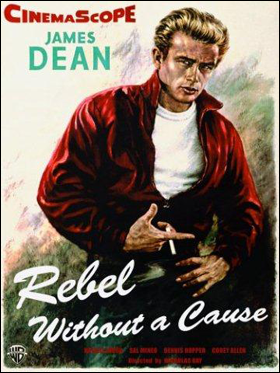 Roadtrip: James Dean Festival in Fairmount
Roadtrip: James Dean Festival in Fairmount
Chris Gahl of the ICVA suggests we head to Fairmount, hometown of the late film actor James Dean, for the 36th annual James Dean Festival, to be held Sept. 23-25. James Dean's untimely death occurred 56 years ago.
The festival includes screenings of all three of
James Dean's films: East of Eden, Rebel Without a Cause and Giant. All festival events are free.
This is a great opportunity to get out and enjoy our refreshing autumn weather.
History Mystery
A top civic leader for the first half of the 20th century - before his death in 1958 - lived in Irvington. In 1880, when Butler University was located in the neighborhood, he was president of his senior class.  Five years later, at age 25, he became the youngest person ever elected to Butler's board of trustees. As a business leader, he had a 77-year career at the Indianapolis News newspaper, working his way up from reporter to editor to top executive. In Irvington, he served as the president of civic and school boards. Buildings are named in his honor, both in the neighborhood and at Butler's current location.
Five years later, at age 25, he became the youngest person ever elected to Butler's board of trustees. As a business leader, he had a 77-year career at the Indianapolis News newspaper, working his way up from reporter to editor to top executive. In Irvington, he served as the president of civic and school boards. Buildings are named in his honor, both in the neighborhood and at Butler's current location.
Question: Name the civic and business leader.
To win the prize, you must call in with the correct answer during the live show. Please do not call if you have won a prize from any WICR show during the last two months. The call-in number is (317) 788-3314, and please do not call until you hear Nelson pose the question on the air.
The prize is a gift certificate for dinner for two at the Mystery Café at the Milano Inn in downtown Indianapolis, the nation's original murder mystery theater. Just in time for Halloween! This prize is courtesy of the ICVA.
Your Hoosier History Live! team,
Nelson Price, host and creative director
Molly Head, producer, (317) 927-9101
Chris Gahl, Roadtripper
Richard Sullivan, webmaster and tech director
Pam Fraizer, graphic designer
Garry Chilluffo, creative consultant
Michele Goodrich, Jed Duvall, grant consultants
www.hoosierhistorylive.org
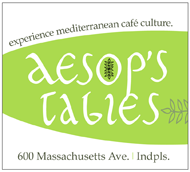



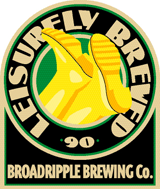


Please tell our sponsors that you appreciate their support: Aesop's Tables, Broad Ripple Brewpub, Broad Ripple Historic Home Tour, Indiana Historical Society, Lucas Oil, Story Inn and Yats restaurants.
 Acknowledgments to Print Resources, Indianapolis Marion County Public Library, Monomedia, Indiana Humanities, Indianapolis Convention & Visitors Association, WICR-FM, Fraizer Designs, Heritage Photo and Research Services, Derrick Lowhorn, Samantha Stratton and many other individuals and organizations. We are an independently produced program and are self-supporting through organizational sponsorships, grants and through individual tax-deductible contributions through the Indiana Humanities Council. Visit our website to learn how you can support us financially.
Acknowledgments to Print Resources, Indianapolis Marion County Public Library, Monomedia, Indiana Humanities, Indianapolis Convention & Visitors Association, WICR-FM, Fraizer Designs, Heritage Photo and Research Services, Derrick Lowhorn, Samantha Stratton and many other individuals and organizations. We are an independently produced program and are self-supporting through organizational sponsorships, grants and through individual tax-deductible contributions through the Indiana Humanities Council. Visit our website to learn how you can support us financially.
Social media reminder
You can like us; you can really like us
Remember that you can "like" Hoosier History Live! on Facebook, and you can make comments about the show there as well. Also, if this newsletter has been forwarded to you, you can get your own subscription by signing up at hoosierhistorylive.org.
Sept. 24 show
Catholic Youth Organization heritage
Summer camps, movie nights, sports competitions, hobby shows and science fairs. All have figured in the lives of thousands of Hoosier teenagers and children since the late 1930s because of the Catholic Youth Organization (CYO), which will be the focus of our show just before a related national gathering in Indy.
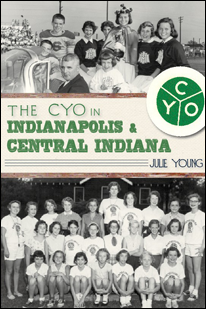 According to a new book, The CYO in Indianapolis & Central Indiana (The History Press), the first CYO event in the Hoosier capital was a dance in 1939 at Cathedral High School (then located downtown on North Meridian Street) that drew more than 1,000 teenagers from every parish in the city.
According to a new book, The CYO in Indianapolis & Central Indiana (The History Press), the first CYO event in the Hoosier capital was a dance in 1939 at Cathedral High School (then located downtown on North Meridian Street) that drew more than 1,000 teenagers from every parish in the city.
The book's author, Julie Young, had her first CYO experience decades later as a 9-year-old. She made an apple pie in a hobby show competition - and won first place in her parish. To explore the heritage and impact of the CYO across Indiana, Julie will join Nelson in studio.
So will Ed Tinder, executive director of the CYO in the Archdiocese of Indianapolis.
Launched in Chicago as a way to offer spiritual, social, athletic and cultural programming for young people, the CYO immediately created a major impact in Indiana, with some youths meeting their future spouses at the array of events, according to Julie's book.
In 1946, the CYO opened a summer camp in Brown County called Rancho Framasa – or "the Ranch," as it has come to be known to scores of Catholic youth. A second, more rugged CYO camp, Camp Christina, also was established in Brown County. Julie's book describes how Camp Christina became a refuge in the early 1960s for Cuban girls attending Ladywood Academy (later merged with Cathedral); their families had escaped the Castro regime in their homeland.
More than 20,000 people are expected Nov. 17-19 to attend the National Catholic Youth Conference at the Indiana Convention Center.
© 2011 Hoosier History Live! All rights reserved.